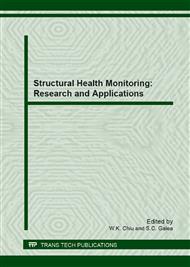[1]
D. A. Scott, D. C. Price, Health Monitoring of Thermal Protection Systems. Report 1: Preliminary Measurements and Design Specifications, CSIRO Materials Science & Engineering, Report no. CIP 2687, 2007. Published as NASA Contractor Report NASA/CR-2007-215092, at http://ntrs.nasa.gov/archive/nasa/casi.ntrs.nasa.gov/20080015624_2008006289.pdf
DOI: 10.1016/0142-1123(91)90371-5
Google Scholar
[2]
N. Hoschke, D. C. Price, D. A. Scott, Monitoring of Thermal Protection Systems using Robust Self-organizing Optical Fibre Sensing Networks. Report 2: Feasibility and Initial Design Study, CSIRO Materials Science & Engineering, Report no. EP 105430, 2010.
Google Scholar
[3]
N. Hoschke, D. C. Price, Monitoring of Thermal Protection Systems using Robust Self-organizing Optical Fibre Sensing Networks. Report 3: Completion of Design Study, CSIRO Materials Science & Engineering, 2012.
Google Scholar
[4]
D. A. Scott, D. C. Price, N. Hoschke, W. L. Richards, Structural health monitoring of thermal protection systems, Materials Forum 33 (2009) 457-64. [in Proceedings of the 2nd Asia-Pacific Workshop on Structural Health Monitoring (2APWSHM), Melbourne, December 2008].
DOI: 10.4028/www.scientific.net/kem.558.268
Google Scholar
[5]
N. Hoschke, C. J. Lewis, D. C. Price, D. A. Scott, V. Gerasimov, P. Wang, A self-organizing sensing system for structural health monitoring of aerospace vehicles, in: Mikhail Prokopenko (Ed.), Advances in Applied Self-Organizing Systems, Springer-Verlag, London, 2008, pp.51-75.
DOI: 10.1007/978-1-84628-982-8_4
Google Scholar
[6]
E. Venkatapathy et al., Thermal protection system technologies for enabling future sample return missions, White paper submitted to the NRC Planetary Science Decadal Survey, Primitive Bodies Sub-panel (2010) http://www.lpi.usra.edu/decadal/sbag/topical_wp/EthirajVenkatapathy.pdf
DOI: 10.3847/25c2cfeb.72d83582
Google Scholar
[7]
M. Froggatt, Distributed measurement of the complex modulation of a photoinduced Bragg grating in an optical fiber, Applied Optics, 35 (1996) 5162-4.
DOI: 10.1364/ao.35.005162
Google Scholar
[8]
M. Froggatt, J. Moore, Distributed measurement of static strain in an optical fiber with multiple Bragg gratings at nominally equal wavelengths, Applied Optics, 37 (1998) 1741-6.
DOI: 10.1364/ao.37.001741
Google Scholar
[9]
W. L. Richards, A. R. Parker, W. L. Ko, A. Piazza, P. Chan, Application of Fiber Optic Instrumentation, NATO RTO AGARDograph 160, Flight Test Instrumentation Series, Volume 22, 2012. (http://www.cso.nato.int/Pubs/rdp.asp?RDP=RTO-AG-160-V22).
Google Scholar
[10]
G. A. Alers, R. M. Zimmerman, Ultrasonic characterization of the thermal protection tiles for the space shuttle, in: B. R. McAvoy (Ed.), 1980 Ultrasonics Symposium Proceedings, IEEE Press, 1980, pp.894-6.
DOI: 10.1109/ultsym.1980.197528
Google Scholar
[11]
Information in http://www.zircarceramics.com/pages/rigidmaterials/specs/zal15.htm
Google Scholar
[12]
C. B. Scruby, L. E. Drain, Laser Ultrasonics, Adam Hilger, Bristol U.K., 1990.
Google Scholar
[13]
S. J. Davies, C. Edwards, G. S. Taylor, S. B. Palmer, Laser-generated ultrasound: its properties, mechanisms and multifarious applications, J. Phys. D: Appl. Phys. 26 (1993) 329-48.
DOI: 10.1088/0022-3727/26/3/001
Google Scholar
[14]
For example: J. L. Rose, Ultrasonic Waves in Solid Media, Cambridge University Press, 2004. J. F. Nye, Physical Properties of Crystals, Oxford University Press, 1985.
Google Scholar


